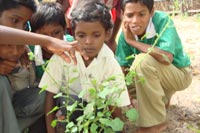“We call on all members of society to join us in a global movement that will help build a world fit for children through upholding our commitments to the following principles and objectives…
“Protect the Earth for children. We must safeguard our natural environment, with its diversity of life, its beauty and its resources, all of which enhance the quality of life, for present and future generations. We will give every assistance to protect children and minimize the impact of natural disasters and environmental degradation on them.”
— A World Fit for Children, 2002,
para. 7, section 10, UN General Assembly
Special Session on Children, 2002
Children Movement for Climate Justice is a children led network for ensuring ecological rights of children as part of overall child rights as specified in UNCRC. This initiative is an offshoot of KNH partners working group in India. Based on the outcomes of KNH partners working group, Resource Centre for participatory Development Studies – RCPDS, one of KNH partner, started this initiative in a small way with 30 members in one of the panchayat in 2007. Gradually this initiative and model was taken up by other NGOs working in Virudhunagar district and other partners of KNH in India. During the past years CMCJ children were involved in various activities to address climate change from rights perspective and carried out various mitigation and advocacy activities. Efforts of children have been greatly appreciated by many development oriented organization both National and International.
Currently CMCJ is spread across four states of India (Tamilnadu, Andrapradesh, Karnataka and Odisha) with more than 15000 plus children as members. Members of CMCJ have been involved in conducting participatory studies across various food security issues, revival of traditional herbal and organic farming knowledge and study of endangered species due to climate change. CMCJ in Virudunagar district of Tamilnadu jointly with District administration conducted awareness campaign on environment protection, anti polythene campaign and promotion of green cover by planting 1,00,000 seedlings in eight blocks of the district. These children have done an advocacy program during May 2009 wherein more than 5,000 children demonstrated in eight different blocks which created an impact on children gaining participation and representation at the child rights protection committee at the district level.
Having grown to a size of working for protection of environment and mitigating climate change across four states, members of CMCJ evolved a working group of 42 members drawn from all four states. This working group meets twice a year to make their plans for six months especially concentrating in the area of building peer pressure to mitigate climate change, disaster preparedness and effective use of existing child rights friendly legal systems etc. Also the consultative meetings provide space for building leadership skills and sharpening children perspective on saving mother earth.
Local NGOs supported by Kindernothilfe Germany and Christian Children Fund of Canada being organizations that work in line with UNCRC to protect child rights jointly with Ministry of Women and Children, Government of India feel it is important we strengthen such initiative to make an impact on the development agenda which will support the cause of child rights approach and children taking the lead on their own on a sustainable basis. While dealing with climate, it is also realized that we link children to child friendly legislations and judicial frameworks to best utilize existing policy frameworks.
The movement helps young people to be aware of the need to protect the environment. During the consultancy meetings when children are asked to list the issues that most concern them, one issue that features highly on their agenda is climate change. While we still have a lot to learn about the consequences of climate change, economic and social development cannot be sustainable unless we deal decisively with this issue. It has the potential to add to the insecurity faced by the most vulnerable people in arid, semi-arid and coastal livelihoods. Millions of young lives which have been at risk were saved by the expansion of such basic services as primary health care, nutrition programmes, and adequate water supply and sanitation, and progressive plans of Government of India. This effort is appreciated by our movement as well by facilitating NGOs. Our CMCJ movement would like to challenge and reassure our government that we children of India are ready to work closely with government and work with personal commitment to reduce pollution, preserving environmental diversity, protecting water supplies and water bodies and increasing access to proper sanitation since these are basics to protection of child rights.
We, as children movement, emphasize the value of education in the context of sustainable environment and promotion of alternate energy. While appreciating the commitment of our government to the educational right of children compulsory and free for all, our movement also urges education system to include information about the dangers of environmental degradation, excess use and exploitation of natural resources and excess dependency on fossil fuel or energy.

